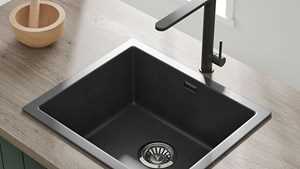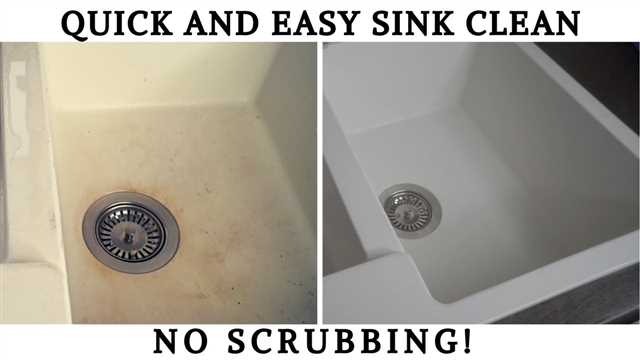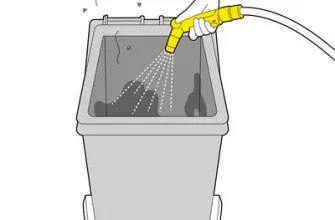
Taking care of your composite sink requires some tips and tricks to keep it looking brand new. With its tough and resilient surface, composite sinks can withstand daily use without showing signs of wear and tear. However, they are prone to limescale buildup and can easily become stained if not properly maintained.
Every time you use your sink, make sure to bring out its full potential by following these simple cleaning methods:
- Remove any food particles or debris by going over the sink with a soft brush or sponge.
- Rinsing the sink after each use will make it easier to keep clean and prevent any limescale or mineral buildup.
- For darker composite sinks, leave a mixture of vinegar and water on the surface for a few minutes, then wipe it away with a lint-free cloth. This will help to remove any stubborn stains and keep it looking as good as new.
- If you’re concerned about having a clean and sanitary sink, there are specialises composite sink cleaners that can really make a difference. They work great on tough stains and make the sink shine.
Regardless of the material of your composite sink, it’s important to follow these cleaning methods to keep it looking great for a long time. Whether you have a white or granite composite sink, these tips will help you maintain its attractive and functional appearance. So don’t wait too long to start taking care of your sink; follow these steps and enjoy a clean and beautiful kitchen.
- How to Care for a Granite Composite Sink Ongoing
- Clean it every day
- Step 3: Rinse and Dry
- Tips for rinsing and drying:
- How to Clean a Composite Sink
- Step 1: Remove dishes and debris
- Step 2: Rinse the sink
- Step 3: Use a mild cleanser
- Step 4: Remove stubborn stains
- Step 5: Rinse and dry
- Step 6: Use vinegar for scale buildup
- Step 7: Buff for a shiny finish
- Ongoing care tips
- Top Tips for a Cleaner Sink
- 1. Use a gentle cleaning solution
- 2. Don’t let the drain clog
- 3. Use bicarbonate soda for tough stains
- 4. Vinegar is your best friend
- 5. Avoid abrasive cleaners
- 6. Clean daily, if possible
- 7. Know the specific care instructions for your sink material
- 8. Use a nylon brush for tough stains
- 9. Keep pets away from the sink
- 10. Avoid using harsh chemicals
- Using Washing Up Liquid to Clean and Maintain a Composite Sink
- Step 1: Prepare the Sink
- Step 2: Create a Soapy Solution
- Step 3: Scrub the Sink
- Step 4: Rinse and Dry
- Step 5: Addressing Tough Stains
- Step 6: Preventing and Addressing Limescale
- Mineral oil
- Video:
- Watch First Before Buying a Kitchen Sink
How to Care for a Granite Composite Sink Ongoing
Cleaning and maintaining a granite composite sink is essential to keep it looking attractive and in top condition. Here are some tips on how to care for your sink on an ongoing basis:
- Clean regularly: Wiping down the sink with a gentle cleaner and water is usually sufficient for day-to-day cleaning. Use a soft cloth or sponge to avoid any potential damage to the surface.
- Rinse thoroughly: After using any cleaner, make sure to rinse the sink thoroughly with water to remove any residue. This will help to keep the sink looking clean and prevent any build-up over time.
- Use a vinegar and water solution: If you’re concerned about limescale or mineral scale, a mixture of white vinegar and water can be used to remove these deposits. Simply spray the solution onto the sink, let it sit for a few minutes, and then wipe it away with a soft cloth or sponge.
- Avoid abrasive cleansers: When cleaning your granite composite sink, avoid using abrasive cleansers or scrubbing pads, as they can scratch or damage the surface. Stick to gentle cleaners and non-abrasive tools.
- Keep within the manufacturer’s recommendations: Each composite sink is different, so it’s important to follow the manufacturer’s recommendations for cleaning and maintenance. This will ensure that you don’t accidentally damage the sink or void any warranties.
- Be mindful of what goes down the drain: Avoid pouring excessive amounts of hot water or harsh chemicals down the drain, as this can weaken the resin that holds the granite particles together. Also, try to avoid letting food scraps or other debris accumulate in the sink drain, as this can lead to clogs.
- Use a cutting board: If you frequently prepare food in your sink, it’s a good idea to use a cutting board to protect the sink surface from scratches. This will help to keep the sink looking new for longer.
- Handle tough stains with care: If you come across a stubborn stain that regular cleaning methods aren’t removing, you can try using a mild abrasive cleaner. However, make sure to test it on a small, hidden area first to ensure that it doesn’t cause any damage.
- Keep pets and children away: If you have pets or children in your home, it’s important to keep them away from the sink and prevent them from playing or climbing on it. This will help to avoid any potential accidents or damage to the sink.
By following these ongoing care tips, you can ensure that your granite composite sink stays clean, attractive, and in top condition for years to come.
Clean it every day
Keeping your composite sink clean is essential for maintaining its beauty and prolonging its lifespan. Daily cleaning is key to preventing the buildup of dirt, stains, and bacteria.
Here’s a step-by-step guide on how to clean your composite sink every day:
-
Wipe it down: Start by wiping the sink with a damp cloth or sponge to remove any loose debris and food particles. Make sure to clean both the inside and the top of the sink.
-
Use warm soapy water: Fill a basin or the sink itself with warm water and a few drops of dish soap. Use a nylon-bristled brush or sponge to gently scrub the sink, paying special attention to any stained areas or hard-to-reach spots.
-
Rinse thoroughly: Rinse the sink with clean water to remove all the soap residue. Make sure to rinse the entire sink, including the drain.
-
Dry it up: Use a lint-free cloth or paper towel to dry the sink thoroughly. This will help prevent water spots and keep your sink looking shiny and attractive.
-
Optional: Use baking soda and vinegar: If your sink needs a bit more cleaning power or has tougher stains, you can create a paste by mixing baking soda and water. Apply the paste to the stained areas and let it sit for a few minutes before scrubbing with a nylon-bristled brush or sponge. Rinse thoroughly with water and dry.
Remember, daily cleaning is essential, but if you encounter more stubborn stains or mineral deposits, you may need to use specialized cleaners or follow specific instructions from the sink manufacturer. It’s important to always read and follow the manufacturer’s guidelines to avoid damaging your sink.
Step 3: Rinse and Dry
After scrubbing and rinsing your composite sink, it’s important to thoroughly rinse it to make sure all the cleaning products are removed. The last thing you want is to leave any residue that could build up over time and cause damage or stains.
Start by rinsing the sink itself with warm water. Run the faucet and use your hand or a cloth to splash and rinse the entire surface of the sink. Be sure to pay attention to the corners and edges where dirt and grime can accumulate.
Next, dry the sink using a clean cloth or paper towel. This will help to prevent water spots and streaks from forming on the surface. Make sure to dry the sink thoroughly, reaching all the nooks and crannies.
Tips for rinsing and drying:
- Use warm water for rinsing, as it helps to remove any remaining soap residue.
- For a deeper clean and to remove limescale, you can mix equal parts vinegar and warm water. Use this mixture for rinsing the sink, and make sure to rinse it again with plain water afterwards to remove the vinegar smell.
- If you’re dealing with stubborn stains or mineral build-up, you can try using a bicarbonate of soda paste. Apply the paste to the affected area and use a non-scratch nylon brush or cloth to scrub it in circular motions. Rinse thoroughly afterwards.
- Always make sure to thoroughly rinse the sink after using any cleaning product to avoid any potential chemical reactions with other materials.
By following these steps and taking proper care of your composite sink, you’ll be able to keep it looking its best for a long time. Remember to regularly clean and dry your sink to prevent any build-up or damage. With a little extra effort, you can enjoy a beautiful, clean sink that will be the centerpiece of your kitchen.
How to Clean a Composite Sink
Cleaning a composite sink is easy and requires a few simple steps to keep it looking its best. Follow these tips to keep your composite sink in top condition:
Step 1: Remove dishes and debris
Before starting the cleaning process, remove any dishes, debris, or food particles from the sink.
Step 2: Rinse the sink
Rinse the sink with warm water to remove any loose dirt or residue.
Step 3: Use a mild cleanser
If needed, use a mild dish soap or a gentle cleanser specifically designed for composite sinks. Apply the cleanser to a lint-free cloth or sponge and scrub the entire sink surface.
Step 4: Remove stubborn stains
If you have stubborn stains or marks, use a mixture of baking soda and water to create a paste. Apply the paste to the stain and gently scrub with a nylon brush or sponge.
Step 5: Rinse and dry
Rinse the sink thoroughly with warm water to remove any residue from the cleanser or baking soda. Use a clean, lint-free cloth to dry the sink to prevent water spots.
Step 6: Use vinegar for scale buildup
If your composite sink has scale buildup, create a mixture of equal parts water and white vinegar. Apply the mixture to the affected areas and let it sit for a few minutes. Scrub the scale with a soft brush or sponge to remove it.
Step 7: Buff for a shiny finish
To bring out the shine of your composite sink, use a clean, dry cloth to buff the surface. This step is optional but can help restore the sink’s luster.
Ongoing care tips

- Regularly wipe down your composite sink with a damp cloth to remove any debris or dirt.
- Avoid leaving standing water or wet sponges in the sink for extended periods, as this can cause staining.
- When cleaning your composite sink, avoid using abrasive cleaners or scrub brushes, as they can cause scratches.
- For tougher stains or marks, a composite sink cleanser specially designed for composite materials may be necessary.
By following these simple steps and ongoing care tips, you can keep your composite sink looking clean and functional for years to come.
Top Tips for a Cleaner Sink
1. Use a gentle cleaning solution
If you have hard water or scale buildup, a combination of liquid soap and warm water can be used to make a gentle cleaning solution. This will help bring shine back to your sink without causing any damage or scratches.
2. Don’t let the drain clog

Regardless of what material your sink is made of, it’s important to keep the drain clear to avoid any clogs. Make sure to regularly clean the drain and remove any debris that might have accumulated over time.
3. Use bicarbonate soda for tough stains
If you are concerned about stains or limescale buildup, bicarbonate soda is a natural and effective option. Mix a small amount of bicarbonate soda with water to create a paste. Apply the paste to the problem areas and scrub gently with a soft cloth or sponge.
4. Vinegar is your best friend
Vinegar is a versatile cleaning solution that can be used to keep your sink looking its best. It contains acetic acid, which helps to break down dirt and grime. Dilute vinegar with water in a 1:1 ratio and use it to wipe down the sink with a lint-free cloth.
5. Avoid abrasive cleaners
When cleaning your sink, it’s important to avoid abrasive cleaners that can scratch the surface. Instead, opt for gentle cleaning solutions and soft cloths or sponges to prevent any damage to your sink.
6. Clean daily, if possible
Keeping up with daily cleaning can go a long way in maintaining a clean and shiny sink. Simply rinsing the sink with water and wiping it down with a cloth can help remove any dirt or grime that may have accumulated throughout the day.
7. Know the specific care instructions for your sink material
Every sink material is different, so it’s important to follow the specific care instructions provided by the manufacturer. This will ensure that you are using the right cleaning products and methods for your sink.
8. Use a nylon brush for tough stains
If you’re dealing with tough stains that won’t come off with regular cleaning methods, a nylon brush can be helpful. Gently scrub the stained area with the brush to remove the stain without causing any damage to the sink.
9. Keep pets away from the sink
If you have pets, it’s a good idea to keep them away from the sink area. They may accidentally scratch the surface or leave behind fur or pet dander, making ongoing cleaning more difficult.
10. Avoid using harsh chemicals
Harsh chemicals, such as bleach or ammonia, should be avoided when cleaning your sink. These can damage the sink’s finish and cause discoloration or other problems. Stick to gentle cleaning solutions and natural alternatives for the best results.
Using Washing Up Liquid to Clean and Maintain a Composite Sink
Composite sinks are a popular choice for many homeowners due to their durability and attractive appearance. To keep them looking their best, regular cleaning and maintenance is necessary. One effective method for cleaning composite sinks is using washing up liquid.
Step 1: Prepare the Sink
Before you start cleaning, make sure the sink is clear of any dishes or other items. Clear away any food particles or minor dirt that may be present on the surface of the sink.
Step 2: Create a Soapy Solution
In a basin or a bowl, mix warm water and a few drops of washing up liquid. The amount of soap will depend on the size of your sink.
Step 3: Scrub the Sink
Immerse a sponge or a soft cloth into the soapy solution and start scrubbing the sink in circular motions. Apply mild pressure on tough stains or limescale deposits, but be gentle to avoid scratching the surface of the sink.
Step 4: Rinse and Dry
Once you have scrubbed the entire sink, rinse it thoroughly with clean water to remove any soap residue. Use a clean, dry cloth or paper towel to dry the sink and prevent water spots.
Step 5: Addressing Tough Stains
If you have any stubborn stains that didn’t come off with the soapy solution, you can try creating a paste with bicarbonate of soda and water. Apply the paste to the stain and scrub gently with a soft brush. Rinse and dry as usual.
Step 6: Preventing and Addressing Limescale
To prevent limescale buildup, you can clean the sink with a mixture of white vinegar and water once a week. Simply spray the mixture onto the sink, leave it to interact for a few minutes, and then rinse and dry as usual. If limescale has already formed, you may require a stronger solution such as a limescale remover or bleach. However, be cautious when using these products and follow the instructions provided.
Overall, washing up liquid is an effective and affordable solution for cleaning and maintaining composite sinks. It will bring back the shine and keep your sink looking as good as new.
Mineral oil
Mineral oil is a great product to use when cleaning and maintaining composite sinks. It helps to remove stains and keep the sink looking fresh and clean.
Here is a step-by-step guide on how to use mineral oil to clean your composite sink:
- First, gather all the materials you will need. This includes mineral oil, a soft cloth or sponge, and a dry cloth for wiping.
- Pour a small amount of mineral oil onto the soft cloth or sponge. You don’t need a lot, just enough to dampen the cloth.
- Wipe the surface of the sink in gentle circular motions. Pay extra attention to areas around the drain, as these often collect more dirt and grime.
- When you come across any minor stains or build-up, apply a bit more pressure and scrub in small circles to remove them. Mineral oil is safe to use on most composite sink materials and won’t damage the surface.
- If the stains are deeper or more stubborn, you can make a paste by mixing mineral oil with baking soda. Apply the paste to the stains, let it sit for a few minutes, and then scrub with a nylon-bristled brush.
- After scrubbing, wipe the sink with a clean, dry cloth to remove any residue.
- For a deeper clean, repeat the process once a week or as needed.
Here are some additional tips for cleaning and maintaining composite sinks:
- Use a non-abrasive cleanser when necessary, but avoid excessive use of abrasive products as they can damage the sink’s surface.
- Rinse the sink thoroughly after each use to remove any residue.
- If your composite sink has a white finish and you notice limescale build-up, you can use a mixture of vinegar and water to remove it. Just be careful not to leave the mixture on for too long, as vinegar can damage the sink in excessive amounts.
- Don’t use bleach or harsh chemicals on your sink, as they can cause discoloration.
- If you’re really concerned about scratches, you can use a cutting board or a mat to protect the sink’s surface.
- When it comes to posts, be sure to clean them as well. Children sometimes get lint-free cloths or sponges and clean posts or other parts of the sink that they see as dirty.
Following these tips and using mineral oil regularly will help keep your composite sink clean and functional for years to come.








